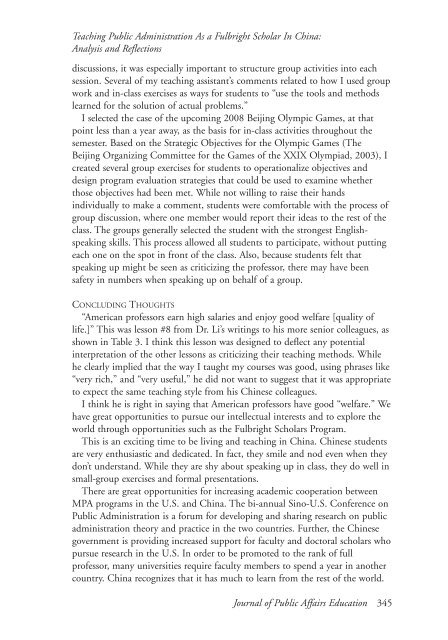journal of public affairs education - NASPAA *The Global Standard ...
journal of public affairs education - NASPAA *The Global Standard ...
journal of public affairs education - NASPAA *The Global Standard ...
- No tags were found...
Create successful ePaper yourself
Turn your PDF publications into a flip-book with our unique Google optimized e-Paper software.
Teaching Public Administration As a Fulbright Scholar In China:Analysis and Reflectionsdiscussions, it was especially important to structure group activities into eachsession. Several <strong>of</strong> my teaching assistant’s comments related to how I used groupwork and in-class exercises as ways for students to “use the tools and methodslearned for the solution <strong>of</strong> actual problems.”I selected the case <strong>of</strong> the upcoming 2008 Beijing Olympic Games, at thatpoint less than a year away, as the basis for in-class activities throughout thesemester. Based on the Strategic Objectives for the Olympic Games (TheBeijing Organizing Committee for the Games <strong>of</strong> the XXIX Olympiad, 2003), Icreated several group exercises for students to operationalize objectives anddesign program evaluation strategies that could be used to examine whetherthose objectives had been met. While not willing to raise their handsindividually to make a comment, students were comfortable with the process <strong>of</strong>group discussion, where one member would report their ideas to the rest <strong>of</strong> theclass. The groups generally selected the student with the strongest Englishspeakingskills. This process allowed all students to participate, without puttingeach one on the spot in front <strong>of</strong> the class. Also, because students felt thatspeaking up might be seen as criticizing the pr<strong>of</strong>essor, there may have beensafety in numbers when speaking up on behalf <strong>of</strong> a group.CONCLUDING THOUGHTS“American pr<strong>of</strong>essors earn high salaries and enjoy good welfare [quality <strong>of</strong>life.]” This was lesson #8 from Dr. Li’s writings to his more senior colleagues, asshown in Table 3. I think this lesson was designed to deflect any potentialinterpretation <strong>of</strong> the other lessons as criticizing their teaching methods. Whilehe clearly implied that the way I taught my courses was good, using phrases like“very rich,” and “very useful,” he did not want to suggest that it was appropriateto expect the same teaching style from his Chinese colleagues.I think he is right in saying that American pr<strong>of</strong>essors have good “welfare.” Wehave great opportunities to pursue our intellectual interests and to explore theworld through opportunities such as the Fulbright Scholars Program.This is an exciting time to be living and teaching in China. Chinese studentsare very enthusiastic and dedicated. In fact, they smile and nod even when theydon’t understand. While they are shy about speaking up in class, they do well insmall-group exercises and formal presentations.There are great opportunities for increasing academic cooperation betweenMPA programs in the U.S. and China. The bi-annual Sino-U.S. Conference onPublic Administration is a forum for developing and sharing research on <strong>public</strong>administration theory and practice in the two countries. Further, the Chinesegovernment is providing increased support for faculty and doctoral scholars whopursue research in the U.S. In order to be promoted to the rank <strong>of</strong> fullpr<strong>of</strong>essor, many universities require faculty members to spend a year in anothercountry. China recognizes that it has much to learn from the rest <strong>of</strong> the world.Journal <strong>of</strong> Public Affairs Education 345
















